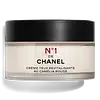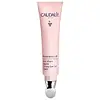What's inside
What's inside
 Key Ingredients
Key Ingredients

 Benefits
Benefits

 Concerns
Concerns

 Ingredients Side-by-side
Ingredients Side-by-side

Camellia Japonica Flower Water
Skin ConditioningWater
Skin ConditioningGlycerin
HumectantButylene Glycol
HumectantSqualane
EmollientSodium Acrylates Copolymer
Propanediol
SolventAlbizia Julibrissin Bark Extract
MaskingCamellia Japonica Seed Oil
EmollientSaccharomyces Cerevisiae Extract
Skin ConditioningFaex
Skin ConditioningCamellia Japonica Flower Extract
EmollientSigesbeckia Orientalis Extract
Skin ConditioningPentylene Glycol
Skin ConditioningEthylhexylglycerin
Skin ConditioningCellulose
AbsorbentLecithin
EmollientPhospholipids
Skin ConditioningSclerotium Gum
Emulsion StabilisingChlorphenesin
AntimicrobialEscin
TonicCaprylyl Glycol
EmollientCyamopsis Tetragonoloba Gum
Emulsion StabilisingMaltodextrin
AbsorbentBeta-Sitosterol
Emulsion StabilisingArginine
MaskingTocopherol
AntioxidantAdenosine
Skin ConditioningSodium Hyaluronate
HumectantLactic Acid
Buffering1,2-Hexanediol
Skin ConditioningTin Oxide
AbrasiveSodium Benzoate
MaskingPalmitoyl Tetrapeptide-7
Skin ConditioningCI 77891
Cosmetic ColorantMica
Cosmetic ColorantCamellia Japonica Flower Water, Water, Glycerin, Butylene Glycol, Squalane, Sodium Acrylates Copolymer, Propanediol, Albizia Julibrissin Bark Extract, Camellia Japonica Seed Oil, Saccharomyces Cerevisiae Extract, Faex, Camellia Japonica Flower Extract, Sigesbeckia Orientalis Extract, Pentylene Glycol, Ethylhexylglycerin, Cellulose, Lecithin, Phospholipids, Sclerotium Gum, Chlorphenesin, Escin, Caprylyl Glycol, Cyamopsis Tetragonoloba Gum, Maltodextrin, Beta-Sitosterol, Arginine, Tocopherol, Adenosine, Sodium Hyaluronate, Lactic Acid, 1,2-Hexanediol, Tin Oxide, Sodium Benzoate, Palmitoyl Tetrapeptide-7, CI 77891, Mica
Water
Skin ConditioningButylene Glycol
HumectantGlycerin
HumectantCoco-Caprylate/Caprate
EmollientIsoamyl Laurate
EmollientPolyacrylate Crosspolymer-6
Emulsion StabilisingEthylhexylglycerin
Skin ConditioningSodium Polyacrylate
AbsorbentPalmitoyl Grapevine Shoot Extract
AntioxidantSclerotium Gum
Emulsion StabilisingXanthan Gum
EmulsifyingChenopodium Quinoa Seed Extract
Skin ConditioningHelianthus Annuus Seed Oil
EmollientTocopherol
AntioxidantBenzyl Alcohol
PerfumingHydrolyzed Hyaluronic Acid
HumectantCaesalpinia Spinosa Fruit Extract
Skin ProtectingAdenosine
Skin ConditioningAcetyl Dipeptide-1 Cetyl Ester
Skin ConditioningSodium Phytate
Sodium Benzoate
MaskingKappaphycus Alvarezii Extract
Skin ConditioningHyaluronic Acid
HumectantPentylene Glycol
Skin ConditioningKhaya Senegalensis Bark Extract
Skin ProtectingMaltodextrin
AbsorbentPaeonia Lactiflora Root Extract
Skin ConditioningNicotiana Benthamiana Hexapeptide-40 Sh-Polypeptide-47
Skin ConditioningWater, Butylene Glycol, Glycerin, Coco-Caprylate/Caprate, Isoamyl Laurate, Polyacrylate Crosspolymer-6, Ethylhexylglycerin, Sodium Polyacrylate, Palmitoyl Grapevine Shoot Extract, Sclerotium Gum, Xanthan Gum, Chenopodium Quinoa Seed Extract, Helianthus Annuus Seed Oil, Tocopherol, Benzyl Alcohol, Hydrolyzed Hyaluronic Acid, Caesalpinia Spinosa Fruit Extract, Adenosine, Acetyl Dipeptide-1 Cetyl Ester, Sodium Phytate, Sodium Benzoate, Kappaphycus Alvarezii Extract, Hyaluronic Acid, Pentylene Glycol, Khaya Senegalensis Bark Extract, Maltodextrin, Paeonia Lactiflora Root Extract, Nicotiana Benthamiana Hexapeptide-40 Sh-Polypeptide-47
 Reviews
Reviews

Ingredients Explained
These ingredients are found in both products.
Ingredients higher up in an ingredient list are typically present in a larger amount.
Adenosine is in every living organism. It is one of four components in nucleic acids that helps store our DNA.
Adenosine has many benefits when used. These benefits include hydrating the skin, smoothing skin, and reducing wrinkles. Once applied, adenosine increases collagen production. It also helps with improving firmness and tissue repair.
Studies have found adenosine may also help with wound healing.
In skincare products, Adenosine is usually derived from yeast.
Learn more about AdenosineButylene Glycol (or BG) is used within cosmetic products for a few different reasons:
Overall, Butylene Glycol is a safe and well-rounded ingredient that works well with other ingredients.
Though this ingredient works well with most skin types, some people with sensitive skin may experience a reaction such as allergic rashes, closed comedones, or itchiness.
Learn more about Butylene GlycolEthylhexylglycerin (we can't pronounce this either) is commonly used as a preservative and skin softener. It is derived from glyceryl.
You might see Ethylhexylglycerin often paired with other preservatives such as phenoxyethanol. Ethylhexylglycerin has been found to increase the effectiveness of these other preservatives.
Glycerin is already naturally found in your skin. It helps moisturize and protect your skin.
A study from 2016 found glycerin to be more effective as a humectant than AHAs and hyaluronic acid.
As a humectant, it helps the skin stay hydrated by pulling moisture to your skin. The low molecular weight of glycerin allows it to pull moisture into the deeper layers of your skin.
Hydrated skin improves your skin barrier; Your skin barrier helps protect against irritants and bacteria.
Glycerin has also been found to have antimicrobial and antiviral properties. Due to these properties, glycerin is often used in wound and burn treatments.
In cosmetics, glycerin is usually derived from plants such as soybean or palm. However, it can also be sourced from animals, such as tallow or animal fat.
This ingredient is organic, colorless, odorless, and non-toxic.
Glycerin is the name for this ingredient in American English. British English uses Glycerol/Glycerine.
Learn more about GlycerinMaltodextrin is a polysaccharide. It is derived from starch such as rice, corn, wheat, or potato starch.
In food, Maltodextrin is used to improve the texture and thicken a product. Due to its structure, it can help create a gel texture. As an emulsion stabilizer, it helps keep the ingredients in a product together.
As a polysaccharide, Maltodextrin has moisturizing properties. Polysaccharides are a type of carbohydrate. The top layer of skin uses polysaccharides to retain water, keeping the skin hydrated.
Maltodextrin is water soluble and has a sweet taste.
Learn more about MaltodextrinPentylene glycol is typically used within a product to thicken it. It also adds a smooth, soft, and moisturizing feel to the product. It is naturally found in plants such as sugar beets.
The hydrophilic trait of Pentylene Glycol makes it a humectant. As a humectant, Pentylene Glycol helps draw moisture from the air to your skin. This can help keep your skin hydrated.
This property also makes Pentylene Glycol a great texture enhancer. It can also help thicken or stabilize a product.
Pentylene Glycol also acts as a mild preservative and helps to keep a product microbe-free.
Some people may experience mild eye and skin irritation from Pentylene Glycol. We always recommend speaking with a professional about using this ingredient in your routine.
Pentylene Glycol has a low molecular weight and is part of the 1,2-glycol family.
Learn more about Pentylene GlycolSclerotium Gum is a polysaccharide gum made by the fungus, Sclerotium rolfssii. It is similar to xanthan gum.
In cosmetics, Sclerotium Gum is used to thicken the texture and to help stabilize other ingredients.
As an emulsifier, Sclerotium Gum helps prevent ingredients from separating, such as water and oil.
Learn more about Sclerotium GumSodium Benzoate is a preservative. It's used in both cosmetic and food products to inhibit the growth of mold and bacteria. It is typically produced synthetically.
Both the US FDA and EU Health Committee have approved the use of sodium benzoate. In the US, levels of 0.1% (of the total product) are allowed.
Sodium benzoate works as a preservative by inhibiting the growth of bacteria inside of cells. It prevents the cell from fermenting a type of sugar using an enzyme called phosphofructokinase.
It is the salt of benzoic acid. Foods containing sodium benzoate include soda, salad dressings, condiments, fruit juices, wines, and snack foods.
Studies for using ascorbic acid and sodium benzoate in cosmetics are lacking, especially in skincare routines with multiple steps.
We always recommend speaking with a professional, such as a dermatologist, if you have any concerns.
Learn more about Sodium BenzoateTocopherol (also known as Vitamin E) is a common antioxidant used to help protect the skin from free-radicals and strengthen the skin barrier. It's also fat soluble - this means our skin is great at absorbing it.
Vitamin E also helps keep your natural skin lipids healthy. Your lipid skin barrier naturally consists of lipids, ceramides, and fatty acids. Vitamin E offers extra protection for your skin’s lipid barrier, keeping your skin healthy and nourished.
Another benefit is a bit of UV protection. Vitamin E helps reduce the damage caused by UVB rays. (It should not replace your sunscreen). Combining it with Vitamin C can decrease sunburned cells and hyperpigmentation after UV exposure.
You might have noticed Vitamin E + C often paired together. This is because it is great at stabilizing Vitamin C. Using the two together helps increase the effectiveness of both ingredients.
There are often claims that Vitamin E can reduce/prevent scarring, but these claims haven't been confirmed by scientific research.
Learn more about TocopherolWater. It's the most common cosmetic ingredient of all. You'll usually see it at the top of ingredient lists, meaning that it makes up the largest part of the product.
So why is it so popular? Water most often acts as a solvent - this means that it helps dissolve other ingredients into the formulation.
You'll also recognize water as that liquid we all need to stay alive. If you see this, drink a glass of water. Stay hydrated!
Learn more about Water